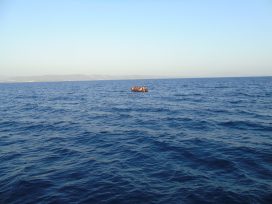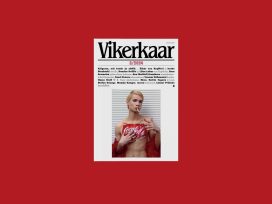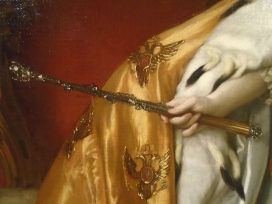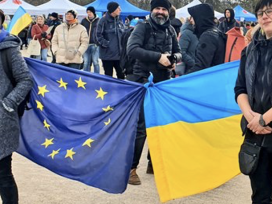The Hungarian philosopher Agnes Heller, in a chapter she contributed to a book published in 1992, stated with some confidence her view that there was no such thing as European culture. There was certainly, she wrote, Italian and German music, and Florentine and Venetian painting, “but there is no European music and no European painting”.
It is true that the history of art and culture was not really Heller’s field, but it would seem that those who, in the same year as she wrote her essay, framed the Maastricht Treaty, signalling the transition from European Community to European Union, at least partially agreed with her. The treaty was the first time the community had taken for itself significant powers in the cultural field. European cultures (note the plural), the relevant article stated, were to be understood as requiring “respect” – by which one understands freedom from too much supranational interference (“The Community shall contribute to the flowering of the cultures of the member states, while respecting their national and regional diversity”). At the same time however, the Community was to be entrusted with the task of “[b]ringing the common cultural heritage to the fore”.
As with most negotiated texts, there is a compromise lurking here, or possibly a contradiction. First, cultures are to be understood as national (and grudgingly, just a little bit regional); they are even perhaps what define nations, the particular set of practices and inheritances which the Dutch, or the Germans, or the Portuguese have by virtue of their nationality, the thing that they have and no other nation has – that Dutch, that Portuguese thing. And yet it seems, according to Maastricht, that there is also a common cultural heritage which belongs equally to the Dutch and the Germans and the Portuguese. But what is this heritage? Is it something made up of a little bit of everywhere sort of tacked together (“the Europe of Dante, Shakespeare and Goethe” perhaps, to which statesmen like to pay obeisance in their speeches before quickly passing on to more important matters)? Or could it be something more mysterious, something actually European?
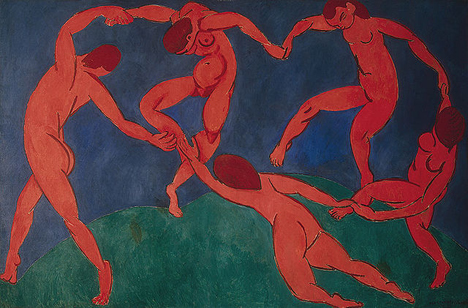
Henri Matisse: “La Dance” (second version). Source:Wikipedia
In all probability the form of words used in Article 128 (now Article 151) of the Maastricht Treaty arose from a conflict between national, or nationalist, sensitivity, some mildly separatist or regionalist traditions and supranational idealism, or, if you like, Brussels overreaching. In the current balance of power in the union the first tends to be stronger than any of the others. When the French talk of culture they mean Racine, while the Italians mean Petrarch and Dante. They may also of course be “convinced Europeans”, in which case they will wish to share Racine, or Petrarch and Dante, with all their neighbours. Of a putative European culture they will ask “How much of ours will get in?”
Interestingly, Agnes Heller thought that while there never had been a European culture there might well be one in the future, a position she perhaps derived from her intellectual background in Marxism-Leninism, which as we know regarded man as a plastic creature who could be moulded (for his own good) by engineers of the human soul into something more satisfactory than his current self. And so a person who today feels completely and satisfyingly Lithuanian might well one day, if acted upon by well-crafted and inspiring supranational cultural influences, feel more European than anything else.
These somewhat nebulous questions – is there or is there not a European culture? and should there be one? – are not really susceptible to yes or no answers, but for what it is worth I would suggest that Heller got things rather the wrong way round: there certainly has been a European culture, while it seems now rather doubtful if a new or renewed one can be created, least of all perhaps by our European institutions. But for a culture which does not throw away its past, perhaps what has been still is: Chaucer and Shakespeare, Raphael and Goya, Bach, Haydn and Mozart, Montaigne, Locke and Mill still exist. Indeed they have never been so available in so many attractive forms to so many people, though it must be admitted that they also share the marketplace and must compete for attention with Paulo Coelho and EL James, Andy Warhol, Mariah Carey and Leinster rugby.
Be this as it may, European culture certainly has deep historical roots. But these roots, of course, lie in something quite different from the geographical and political entity that we know as today’s Europe. Europa was first, in Greek mythology, a Phoenician woman abducted by the god Zeus, appearing in the form of a white bull. Then the word came to designate those lands on the western side of the Bosporus (the eastern side being Asia), corresponding to part of modern Bulgaria and “European Turkey”. The Roman world was partly European but also Asian and African, its centre of course being the Mediterranean, the great sea, mare nostrum. The Roman church derived its teachings from the east (Asia and Africa again) but later established its dominion chiefly in western and central Europe. Its bureaucracy and career structure could often be international: the Canterbury archbishops Anselm and Lanfranc were from northern Italy; Alcuin, the leading intellectual presence at Charlemagne’s court, was from York; Columbanus, a major figure who founded monasteries across France and Italy, from the kingdom of Meath. Communication was of course facilitated by the universal knowledge among the educated of Latin and its use in administration, first of all in the ecclesiastical sphere, but after Charlemagne and Alcuin’s reforms also in the civil one.
Peter Burke has shown to what degree the Renaissance was not just an Italian affair but a phenomenon whereby a certain style, which may have started in northern and central Italy, a way of painting, a way of building, a way of thinking, a way of running one’s household if possessed of some power and wealth, spread out dramatically, to France, to Germany, the Netherlands, Poland, Hungary, Bohemia, England, Scotland. Such a dramatic propagation of ideas, objects and practices was facilitated (as Gothic architecture had also been a few centuries before) by a greatly enhanced mobility of craftsmen and artists. And though its cultural energy continued to be remarkable, Italy was not necessarily pre-eminent in every field: the Netherlandish or Northern Renaissance tradition in painting – in particular the work of Jan van Eyck and Rogier van der Weyden – was hugely influential; drama reached its apogee in Elizabethan and Jacobean England, while the most attractive thinker (and human being) of the Renaissance may well have been the Frenchman Michel de Montaigne. The hugely important technological leap of printing with movable type first occurred in Germany; it was quickly carried to Venice, which was the dominant European city of print (in several languages living and “dead”) for several decades at the opening of the sixteenth century, though many of the city’s skilled craftsmen were still drawn from the émigré German community.
The Reformation, and the translation of the Bible into various vernaculars that accompanied it in Protestant lands, certainly dealt a blow to Latin, but not yet a terminal one: a significant proportion of the books sold at Leipzig’s important annual trade fair were in Latin even in the eighteenth century. The Enlightenment, a movement whose leading figures were French, German and Scottish, encouraged intellectuals to speak in optimistic terms of a future Europe with no borders, where liberty, civility and trade would bring together men and nations, no longer held back or kept apart by superstition or obscurantism, in peace and progress. Enlightenment was to be succeeded, and to a degree displaced, by Romanticism, another international cultural phenomenon: the Ossian poems, which the Scot James Macpherson derived from Gaelic oral and (more doubtfully) manuscript sources, adding a great deal of his own, tell the story of a figure based on Oisín, son of Fionn mac Cumhaill. In the two generations after their “discovery”, Macpherson’s epics were translated into French, German, Danish, Swedish, Italian, Spanish, Russian, Dutch, Polish, Czech and Hungarian; they impressed Diderot, Goethe and Napoleon and inspired the music of Schubert and Mendelssohn. The king of Sweden named his only son after a figure from Ossianic legend: he was to become King Oscar I in 1844.
In late October 1787, the Prager Oberamtszeitung newspaper reported (in German) on an exceptional musical event in the Bohemian capital: “Connoisseurs and musicians say that Prague has never heard the like.” The occasion was the first performance of a new work by Wolfgang Amadeus Mozart and his librettist, Lorenzo da Ponte, Il dissoluto punito, ossia il Don Giovanni (The Rake Punished, or Don Giovanni), conducted on the night of its premiere to enormous acclaim by Mozart himself. The performance, at the Teatro di Praga, today the Stavovské divadlo or Estates Theatre, was of a work which was described as a dramma giocosa, though Mozart entered it into his own catalogue as an opera buffa. The story of the heartless seducer Don Juan can be traced back to a seventeenth century Spanish original, of which there are countless later versions, by Molière, Byron, Shaw, Ingmar Bergman and many others. Mozart’s opera of course, if we follow Agnes Heller, must be just another example of German music.
Italian opera (that is opera written by Italians) was of course to be enormously successful across Europe in the nineteenth and twentieth centuries, feeding into, blending with and transforming native musical traditions in several countries. Italian artistic and craft excellence was to facilitate a diaspora of the gifted. Michele Esposito, born near Sorrento, became chief piano teacher at the Royal Irish Academy in Dublin. He heard James Joyce sing and was impressed by his voice. In 1902 he wrote an Irish Symphony and the Esposito family is referred to in Ulysses in connection with an embarrassing incident in which the young Joyce fell down drunk at a play in the Camden hall. Another figure mentioned in Ulysses, the nationalist MP JP Nannetti, was the son of an Italian sculptor who had come to Ireland to avail of the opportunities for well-paid work that arose here in the decades after Catholic Emancipation.
Walter Benjamin called Paris “the capital of the nineteenth century”, but its cultural pre-eminence both preceded that century and lasted well into the twentieth, while its appeal to our romantic impulses remains. Dominating visual art for over a century, France of course produced her own great painters and sculptors but the call of Paris also attracted incomers, the Irish impressionist Roderic O’Conor, a friend of Gauguin, Chagall and Soutine, Jews from the Russian empire, the Romanian Brâncusi, the Spanish Picasso, the Italian Modigliani. Are Modigliani’s famous pictures of elegant, long-necked women examples of Italian art, French art, Parisian art, European art or just art?
Perhaps we have now cited sufficient examples of unifying factors in European cultural history, of powerful movements of renewal which operated across frontiers, of the role of fashion, of the influence at different times in history of particular centres of originality, energy and excellence, which would bring in turn a strong Italian, or French, or German tradition to bear on art and intellectual production across the continent. Though of course some countries were more peripheral to the influence of powerful cross-national influences than others, in general the interconnectedness was so strong and so long-lasting that the notion that there has never been anything other than national musics, national literatures, national traditions of painting is little short of an absurdity. Indeed, the idea that the cultural was chiefly to be found in the deep resources of the nation would have been regarded by most educated people with puzzlement at any time before the nineteenth century – for whom European culture was broadly congruent with culture tout court: Europe was all there was. This position may well have been based on ignorance or arrogance but it was nevertheless generally held. Chinese culture might arguably have been older, deeper and more complex than European. Nevertheless, all that most Europeans thought would be required from them in interactions with the East was to civilize its peoples (often of course a cover for robbing them).
All of this changed in the twentieth century with the inexorable rise of the United States, the growing domination of its industrial artefacts and modes of production and management and the “soft power” of its all-pervasive entertainment industry. The “Yank” first made his presence felt in Europe in a major way in the post-Second World War period, when the natives were hungry, fearful and ideologically divided. Americans not only had the food, the jeeps and the dollars but they knew exactly what to do, an assurance that provoked a strong allergic reaction from many European intellectuals of both left and right, particularly in France. As European nations began the process of coalescing politically from the 1950s onwards their real engagement with each other’s intellectual traditions paradoxically began to falter in the context of the new prestige attached to scientific and management, as opposed to humanist, world views and given the increasing strength of the English language and the (American) cultural values it tends to transmit. There has not of course been a complete eclipse of Europe. Far from it. France is still pretty much France: the shops in her provincial towns still close for a few hours every afternoon in defiance of all commercial logic but in exaltation of the idea of a civilized existence. Italian food has not been drowned in a sea of Coca Cola and you will still find a much better selection of literary novels in translation in an Italian, French, German or Spanish bookshop than you will in an Irish or British one. But the long term trends, if we do nothing, do not particularly seem to favour European culture, or perhaps even culture (the word has many definitions but Matthew Arnold’s – “the best that has been thought and said” – comes closest to the perhaps rather conservative “high-culture” way I have been using it in this essay).
It has been an assumption throughout my exploration of culture and nations that engagement with matters outside one’s own immediate environment is a good thing. In this I follow Montaigne, who remarked that he was ‘scarcely infatuated with the sweetness of my native air’. Such an orientation, however, is not universal and it is certainly not obligatory; nor should it be made so. If it is your belief that the greatest intellectual or spiritual fulfilment is to be derived from a persistent and deep engagement with your national culture and traditions – if necessary to the exclusion of others – that is fine by me. Intellectual provincialism is to be deprecated, but as Ryszard Kapuscinski, citing Eliot, has pointed out, there is more than one kind of provincialism:
We normally associate the concept of provincialism with geographic space. A provincial is one whose worldview is shaped by a certain marginal area to which he ascribes an undue importance, inaptly universalizing the particular. But T.S. Eliot cautions against another kind of provincialism – not of space, but of time. “In our age,” he writes in a 1944 essay about Virgil, “when men seem more than ever prone to confuse wisdom with knowledge, and knowledge with information, and to try to solve problems of life in terms of engineering, there is coming into existence a new kind of provincialism which perhaps deserves a new name. It is a provincialism, not of space but of time: one for which history is merely the chronicle of human devices which have served their turn and been scrapped, one for which the world is the property solely of the living, a property in which the dead hold no shares. The menace of this kind of provincialism is, that we can all, all the peoples on the globe, be provincials together; and those who are not content to be provincials, can only become hermits.
The prospect of becoming a hermit can at times seem tempting, but perhaps it is not necessary to give up on the world just yet. The United States of America has since its foundation functioned as a haven for people fleeing poverty and religious oppression, English Puritans, Irish, Italian and Swedish peasants, Jews fleeing the fierce persecutions of Tsarist Russia, poor farmers from Central America. They are welcome, but they will be expected, over time, to leave behind much of what they have been and to become Americans: e pluribus unum, out of many one. The model often proposed for Europe is a different one, a unitas multiplex in which difference, diversity and complexity and a Babel of languages are accorded a positive value. One should be careful here; it is not necessarily the case that Europe has achieved this enviable state of richness, complexity and tolerance. It is rather something to be striven for, but something that it still seems not unreasonable to strive for. The critical thinkers will always be around to remind us of the more negative aspects of Europe’s history and the need to avoid the besetting sins of cultural pride, essentialism and Eurocentrism.
Meanwhile, the European Union’s cultural record since Maastricht has been mostly a disaster (a notable exception is the excellent internet portal Europeana (europeana.eu), which now provides a way in to millions of digitized books, paintings, films, music and records across Europe). The Union’s current programme (2007-2013), its website tells us, “has a budget of 400 million euros for projects and initiatives to celebrate Europe’s cultural diversity and enhance our shared cultural heritage through the development of cross-border co-operation between cultural operators and institutions”. What this too often means in practice is a cumbersome bureaucracy, the enforcement of bothersome stipulations involving collaboration between institutions and practitioners with little in common and a valuation of the contemporary above the historical or canonical. What stands a very good chance of finding support will be the joint production of a Catalan modern dance troupe, an Estonian free jazz ensemble and a Hungarian video artist, particularly if the application is processed by a professional – another case perhaps of grants for people who are good at applying for grants. What stands less of a chance, it would seem, is an organization that seeks to promote knowledge of and engagement with European culture and ideas across frontiers. The excellent Berlin-based Perlentaucher, which publishes a serious yet engaging online cultural magazine perlentaucher.de with internationalist perspectives in German and which once published a sister site, Signandsight, in English, felt it best to eventually give up its search for EU cultural funding, so byzantine and frustrating did it find the application process.
Culture may be defined in many ways (and of course in ways other than Arnold’s). The French historian Emmanuel Le Roy Ladurie has offered the following encapsulation: “Time is money; free time is culture.” This has the merit of brevity, but other merits too. True it would tend to suggest that culture can be whatever we want it to be, from skittles to string quartets, but it may also suggest that historically those who had the most time (and this was not the poor) produced or more often paid for the most, and the most long-lasting and arguably the most valuable, culture.
Another strongly held idea about culture is that it is not to be understood just as pastime, that it can be a factor which unites us, that contributes to what the Germans splendidly call Zusammengehörigkeitsgefühl, the feeling of belonging together. If the European Union wishes, or needs us, to belong together and to feel that we do so, it might think about reorienting its cultural policy and its considerable spending power away from modish but rickety trinational contemporary art collaborations and seeking to make available, more often and for a broader audience, and in the face of the strong countervailing influences of entertainment and the power of the market, the best that has been thought and said (and sung and painted and danced) by twenty-five centuries of Greeks, Romans, Spanish, Germans, Italians, French, Czechs and Poles. Thus we might hope not to see the memory of our culture eroded in this generation in a fit of solipsistic absent-mindedness and continue to fulfil our duty to act as a bridge between the dead, the living and the yet to be born.
Notes
Agnes Heller’s “Europe: An Epilogue” is in Brian Nelson, David Roberts and Walter Veir (eds.), The Idea of Europe (Berg, 1992). Peter Burke’s reading of the Renaissance is most fully set out in La Renaissance européenne (Seuil, 2000). There is a much shorter treatment of the same matter in English, The Renaissance (Palgrave Macmillan, 1997).
A longer version of this article appears in the Dublin Review of Books.
